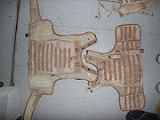
Osprey body armour
Encyclopedia
Osprey body armour is a system of body armour used by the British Armed Forces
. The system is in its fourth iteration following extensive development and engagement with front line users.
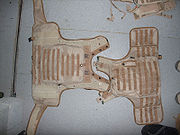
, combating terrorist activities in Northern Ireland
. ECBA was issued to ground force elements during the early stages of Operation Telic
, the invasion of Iraq
in 2003.
Following lessons identified in Iraq by both British and American forces the Osprey armour system was released in 2006 for general use. It has subsequently been developed and in late 2010 Version 4 has been issued to personnel serving in Afghanistan
on Operation Herrick
.
, stitched to the outside to act as a basis for a series of pouches and accessories, removing the need to wear a webbing harness or assault vest over the armour.
The vest consists of a front and rear soft armour panel, which join with the aid of hook & loop fasteners and press studs at the shoulders and waist sides. The panels contain a ceramic trauma plate both front and rear, protected by a rubber surround intended to avoid wear and tear in routine use. Version 4 of the armour introduces additional side panels designed to contain further trauma plates.
Clips on the vest are available for the fitting of a British type Camelbak or Bergen side pouch on the rear, and a respirator haversack on the bottom left.
The armour system is not currently issued to personnel in the UK, and instead retained in theatre, and issued during inward processing. Training is undertaken using earlier versions of Osprey.
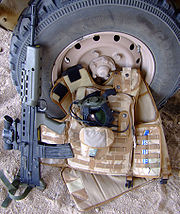
around the armour, hooked to the PALS webbing
, with modifications to the velcro coverage to improve fastening security and an outer cummerbund buckling at the front, rather than the sides. The outer cummerbund also has pockets for trauma plates at the sides.
The pouch system consists of a range of accessories that can be fitted to the vest, allowing an easily configurable load carrying capability that can be tailored to the needs of the individual user. This includes a range of magazine, link
, smoke canisters or grenades
as well as utility pouches and medical packs.
These accessories are mounted using the PALS tape and can also be fitted to any other equipment with this arrangement, such as the issued daysac
.
Initial criticisms of the first generation were related to the significant increase in weight, and size of the trauma plates, compared with the existing ECBA. Media outlets reported that Royal Marines
serving in Afghanistan identified the plates as restricting movement and were discarding them, despite the improved personal protection.
The quality of the manufacture of versions 1 and 2 has been criticised with reports of seams and fasteners tearing open in normal use.
First generation pouches were criticised for poor stability on the cover, with some infantry identifying that pouches designed to hold two magazines did not securely hold three, and that the scale of issue was inadequate to hold a standard patrol ammunition load of six magazines.
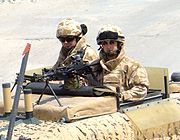
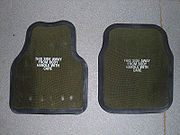
British Armed Forces
The British Armed Forces are the armed forces of the United Kingdom of Great Britain and Northern Ireland.Also known as Her Majesty's Armed Forces and sometimes legally the Armed Forces of the Crown, the British Armed Forces encompasses three professional uniformed services, the Royal Navy, the...
. The system is in its fourth iteration following extensive development and engagement with front line users.

Heritage
British armed forces have used Combat Body Armour, and then Enhanced Combat Body Armour during Operation BannerOperation Banner
Operation Banner was the operational name for the British Armed Forces' operation in Northern Ireland from August 1969 to July 2007. It was initially deployed at the request of the Unionist government of Northern Ireland to support the Royal Ulster Constabulary . After the 1998 Belfast Agreement,...
, combating terrorist activities in Northern Ireland
Northern Ireland
Northern Ireland is one of the four countries of the United Kingdom. Situated in the north-east of the island of Ireland, it shares a border with the Republic of Ireland to the south and west...
. ECBA was issued to ground force elements during the early stages of Operation Telic
Operation Telic
Operation TELIC was the codename under which all British military operations in Iraq were conducted between the start of the Invasion of Iraq on 19 March 2003 and the withdrawal of the last remaining British forces on 22 May 2011...
, the invasion of Iraq
Iraq
Iraq ; officially the Republic of Iraq is a country in Western Asia spanning most of the northwestern end of the Zagros mountain range, the eastern part of the Syrian Desert and the northern part of the Arabian Desert....
in 2003.
Following lessons identified in Iraq by both British and American forces the Osprey armour system was released in 2006 for general use. It has subsequently been developed and in late 2010 Version 4 has been issued to personnel serving in Afghanistan
Afghanistan
Afghanistan , officially the Islamic Republic of Afghanistan, is a landlocked country located in the centre of Asia, forming South Asia, Central Asia and the Middle East. With a population of about 29 million, it has an area of , making it the 42nd most populous and 41st largest nation in the world...
on Operation Herrick
Operation Herrick
Operation Herrick is the codename under which all British operations in the war in Afghanistan have been conducted since 2002. It consists of the British contribution to the NATO-led International Security Assistance Force and support to the US-led Operation Enduring Freedom...
.
Design
The armour system is modular and built around a vest which covers the torso. Protective elements to cover the upper arms and around the neck and throat can be added to the main vest. The vest has webbing tape, similar to the Pouch Attachment Ladder SystemPouch Attachment Ladder System
The Pouch Attachment Ladder System or PALS is a grid of webbing invented and patented by United States Army Natick Soldier Research, Development and Engineering Center used to attach smaller equipment onto load-bearing platforms, such as vests and backpacks...
, stitched to the outside to act as a basis for a series of pouches and accessories, removing the need to wear a webbing harness or assault vest over the armour.
The vest consists of a front and rear soft armour panel, which join with the aid of hook & loop fasteners and press studs at the shoulders and waist sides. The panels contain a ceramic trauma plate both front and rear, protected by a rubber surround intended to avoid wear and tear in routine use. Version 4 of the armour introduces additional side panels designed to contain further trauma plates.
Clips on the vest are available for the fitting of a British type Camelbak or Bergen side pouch on the rear, and a respirator haversack on the bottom left.
The armour system is not currently issued to personnel in the UK, and instead retained in theatre, and issued during inward processing. Training is undertaken using earlier versions of Osprey.

Mk 1
Large trauma plates at the front and back with the assembly as described, offering significant improvements over ECBA protection.Mk 2
The armour was improved by the use of modified pouches, a sling attachment for the rifle and improved construction quality.Mk 3
Improvements to the armour included the addition of a more robust right hand shoulder assembly, and retaining straps over the side panels to reduce instances of the velcro opening when under stress. This had been mitigated in the Mk 2 armour by the use of a bungee cordBungee cord
A bungee cord , also known as a shock cord, is an elastic cord composed of one or more elastic strands forming a core, usually covered in a woven cotton or polypropylene sheath...
around the armour, hooked to the PALS webbing
Mk 4
The cover was made available in the modified camouflage colour, Multi-Terrain PatternMulti-Terrain Pattern
The Multi-Terrain Pattern is a camouflage pattern printed on equipment issued to British forces.As part of the MOD's PECOC programme, three new camouflage patterns were being considered for issue to British forces...
, with modifications to the velcro coverage to improve fastening security and an outer cummerbund buckling at the front, rather than the sides. The outer cummerbund also has pockets for trauma plates at the sides.
System accessories
The Osprey Body Armour is complemented by the Under Body Armour Combat Shirt (UBACS) but can be worn over the CS95 jacket or field jacket. The UBACS torso is made of wicking coolmax fabric with soft protection in the shoulders and sleeves.The pouch system consists of a range of accessories that can be fitted to the vest, allowing an easily configurable load carrying capability that can be tailored to the needs of the individual user. This includes a range of magazine, link
Belt (firearm)
A belt or ammunition belt is a device used to retain and feed cartridges into a firearm. Belts and the associated feed systems are typically employed to feed machine guns or other automatic weapons...
, smoke canisters or grenades
Hand grenade
A hand grenade is any small bomb that can be thrown by hand. Hand grenades are classified into three categories, explosive grenades, chemical and gas grenades. Explosive grenades are the most commonly used in modern warfare, and are designed to detonate after impact or after a set amount of time...
as well as utility pouches and medical packs.
These accessories are mounted using the PALS tape and can also be fitted to any other equipment with this arrangement, such as the issued daysac
Backpack
A backpack is, in its simplest form, a cloth sack carried on one's back and secured with two straps that go over the shoulders, but there can be exceptions...
.
Criticism
Each generation of Osprey has been subjected to some form of criticism from users and journalists.Initial criticisms of the first generation were related to the significant increase in weight, and size of the trauma plates, compared with the existing ECBA. Media outlets reported that Royal Marines
Royal Marines
The Corps of Her Majesty's Royal Marines, commonly just referred to as the Royal Marines , are the marine corps and amphibious infantry of the United Kingdom and, along with the Royal Navy and Royal Fleet Auxiliary, form the Naval Service...
serving in Afghanistan identified the plates as restricting movement and were discarding them, despite the improved personal protection.
The quality of the manufacture of versions 1 and 2 has been criticised with reports of seams and fasteners tearing open in normal use.
First generation pouches were criticised for poor stability on the cover, with some infantry identifying that pouches designed to hold two magazines did not securely hold three, and that the scale of issue was inadequate to hold a standard patrol ammunition load of six magazines.
Confusion with Kestrel body armour
Various media outlets, including the Ministry of Defence itself, have generated some confusion as to the name of Osprey body armour, often incorrectly labelling it as 'Kestrel' in both photo captions and in article text. This was due to the introduction of limited sets of both types of body armour around the same time in late 2005 and early 2006. Kestrel is a single piece body armour unit, looking like a modified bomb-disposal suit and containing the same small plates as the CBA it replaced. It was issued to troops on 'top-cover' as an Urgent Operational Requirement to provide better protection against the effects of IED detonations, but the design and rigidity of the suit left the wearer almost unable to operate his weapon system. With the issue of collar and arm protectors, often known as 'wings' by troops, with every set of Osprey, Kestrel became redundant and was withdrawn from service in late 2006. With Osprey collars and 'wings' fitted the wearer is still capable of operating weapon systems effectively.


